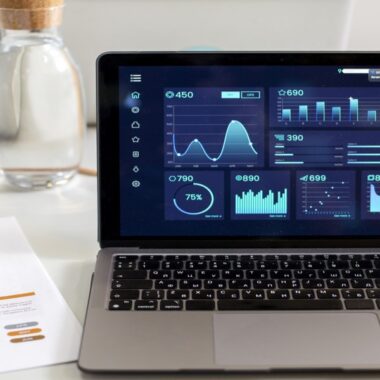Summary: The blog delves into their applications, emphasizing real-world examples in healthcare, finance, retail, and technology. From predicting patient outcomes to optimizing inventory management, these techniques empower decision-makers to navigate data landscapes confidently, fostering informed and strategic decision-making.
Introduction
Statistical modelling is a method used in statistics to represent and analyse relationships between variables within a dataset. It is a mathematical framework that aims to capture the underlying patterns, trends, and structures present in the data.
The statistical models empower analysts to make predictions or gain a deeper understanding of the phenomena under investigation. In 2022, around 97% of the companies invested in Big Data and 91% of them invested in AI, clearly stamping that data is becoming the linchpin for successful business.
At its core, statistical modelling involves the development of a mathematical model based on observed data. This model is designed to describe the probabilistic relationships between different variables and is often expressed through equations or mathematical functions.
The purpose of statistical modelling is to provide a formalized representation of how variables interact or influence each other. In this blog, we are going to explore the different types of statistical modelling and their applications.
Key Components of Statistical Modelling Include
Building a statistical model is like constructing a house. Unravel the key components: data (the foundation), variables (the building blocks), model selection (the blueprint), and parameter estimation (shaping the structure). Here is the details of the key components of statistical modelling:
Data
This is the foundation of any statistical model. It’s the collection of observations you’ll use to build and assess the model. The quality and relevance of your data will directly impact the accuracy and usefulness of your model.
Variables
Data is typically made up of variables, which are characteristics or features that can be measured. These can be independent variables (thought to influence the outcome) and dependent variables (the outcome you’re trying to predict or understand).
Model Selection
There are many different statistical models available, each with its own strengths and weaknesses. Choosing the right model for your data and research question is crucial. Some common models include linear regression, logistic regression, decision trees, and clustering algorithms.
Parameters
Most statistical models involve parameters, which are numerical values that determine the specific form of the model. The process of fitting a model to data involves estimating the values of these parameters.
Assumptions
Statistical models often rely on certain assumptions about the data, such as normality or independence of errors. It’s important to check these assumptions and address any violations before interpreting the model results.
Model Fitting
This is the process of using your chosen model and data to estimate the parameters. There are various statistical techniques used for fitting models, depending on the specific model type.
Model Evaluation
Once you have a fitted model, you need to evaluate its performance. This involves assessing how well the model fits the data and generalizes to unseen data. Common metrics include R-squared, mean squared error, and accuracy.
Interpretation
Once you’re confident in your model, you can use it to interpret the relationships between variables and draw conclusions from your data. This could involve making predictions, understanding causal effects, or identifying patterns.
Statistical modelling finds applications across various fields, including economics, biology, social sciences, and engineering. Different types of statistical models exist, ranging from simple linear regression models to complex machine learning algorithms. The choice of model depends on the nature of the data and the specific goals of the analysis.
Statistical modelling is a powerful tool for extracting knowledge from data. It provides a structured and quantitative framework for understanding complex phenomena and making informed decisions. Owing to its growing applications, the best Data Analytics course includes statistical modelling as a part of its curriculum.
Types Of Statistical Modelling, Along with Examples
Statistical modelling goes beyond just summarizing data. It uses various approaches to uncover patterns and predict future outcomes. These models, like linear regression or decision trees, can be parametric (fixed structure) or non-parametric (flexible structure), depending on the data and question you have.
Linear Regression
It is a foundational statistical modelling technique used to understand the relationship between a dependent variable and one or more independent variables. For example, in finance, linear regression can help predict stock prices based on factors like interest rates, market indices, and historical performance.
Logistic Regression
Logistic regression is employed when the outcome is binary, such as success or failure. In healthcare, it’s utilized to predict the likelihood of a patient developing a specific condition based on various factors like age, lifestyle, and medical history.
Time Series Analysis
This method analyses data points collected over time to predict future trends. In the field of economics, time series models can be used to forecast stock prices, inflation rates, or sales trends, aiding businesses in strategic planning.
Decision Trees
Decision trees are a versatile statistical modelling technique used for decision-making in various industries. In marketing, a decision tree can help determine the most effective advertising channels based on customer demographics, improving campaign targeting and ROI.
Cluster Analysis
It involves grouping similar data points based on certain characteristics. In customer segmentation for e-commerce, cluster analysis can help identify distinct customer groups with similar purchasing behaviour, enabling businesses to tailor marketing strategies for each segment.
Real-World Applications
In this section we will unfold how businesses, science, and everyday life leverage these methods to solve problems, make informed decisions, and even predict future trends. Here are a few of the real-world use cases:
Healthcare: Predictive Modelling for Patient Outcomes
Statistical modelling takes centre stage in predictive analytics. By analysing patient data, healthcare professionals can predict potential health risks and optimize treatment plans. This not only enhances patient care but also contributes to the overall efficiency of healthcare systems.
Finance: Risk Management with Time Series Analysis
In the financial world, where uncertainties are inherent, time series analysis becomes indispensable. By utilizing statistical modelling techniques, financial analysts can predict market trends, assess risks, and make informed investment decisions. This is a game-changer in an environment where timing is everything.
Retail: Demand Forecasting for Inventory Management
Predicting the demand is critical for maintaining optimal inventory levels. Statistical models can analyse past sales data, seasonality, and other factors to forecast future demand accurately, preventing both overstock and stockouts.
Technology: User Behaviour Analysis for Product Enhancement
Leveraging statistical modelling to analyse user behaviour and preferences can be helpful for tech companies. By understanding how users interact with a product, companies can make data-driven improvements, enhancing the overall user experience.
Navigating the Data Landscape with Confidence
Armed with these five statistical Data Analysis techniques and real-world examples, decision-makers can navigate the data landscape with confidence.
Some of the prominent names in the business using Data Analytics are DeepMind, Tesla, Nintendo, HR Wallingford and more.
Whether in retail, finance, healthcare, e-commerce, or marketing, these techniques empower professionals to extract actionable insights, fostering informed decision-making in an ever-evolving world.
Scale Up Your Growth with Pickl.AI
The Data Analytics course by Pickl.AI enables learners to acquire the right skills and knowledge that make them proficient in their domain. Besides, any individual who is starting their career in the data domain can begin with a Data Science course for beginners.
All the courses at Pickl.AI are helmed by practising Data Scientists, thus making your learning journey more effective. For more information, log on to Pickl.AI
Frequently Asked Questions
What are The 5 Data Analysis Techniques?
These techniques include summarizing data (descriptive statistics), finding relationships (correlation), testing hypotheses (t-tests), grouping similar data (clustering), and forecasting future trends (regression).
How Is Data Analysis Used in Real Life?
Companies use it to understand customer behaviour and predict sales. Scientists use it to analyse research findings and test hypotheses. We all use it to make choices, like analysing weather data before an outing.
What Benefit Do These Techniques Provide?
By analysing data, we can uncover hidden patterns, make informed decisions, solve problems, and even predict future trends. This leads to better outcomes in business, science, and everyday life.






